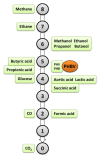The Opportunity for High-Performance Biomaterials from Methane
- PMID: 27681905
- PMCID: PMC5029516
- DOI: 10.3390/microorganisms4010011
The Opportunity for High-Performance Biomaterials from Methane
Abstract
Polyhydroxyalkanoate (PHA) biopolymers are widely recognised as outstanding candidates to replace conventional petroleum-derived polymers. Their mechanical properties are good and can be tailored through copolymer composition, they are biodegradable, and unlike many alternatives, they do not rely on oil-based feedstocks. Further, they are the only commodity polymer that can be synthesised intracellularly, ensuring stereoregularity and high molecular weight. However, despite offering enormous potential for many years, they are still not making a significant impact. This is broadly because commercial uptake has been limited by variable performance (inconsistent polymer properties) and high production costs of the raw polymer. Additionally, the main type of PHA produced naturally is poly-3-hydroxybutyrate (PHB), which has limited scope due to its brittle nature and low thermal stability, as well as its tendency to embrittle over time. Production cost is strongly impacted by the type of the feedstock used. In this article we consider: the production of PHAs from methanotrophs using methane as a cost-effective substrate; the use of mixed cultures, as opposed to pure strains; and strategies to generate a poly(3-hydroxybutyrate-co-3-hydroxyvalerate) copolymer (PHBV), which has more desirable qualities such as toughness and elasticity.
Keywords: PHA; PHB; PHBV; biopolymer; gas fermentation; methane; syngas methanotroph.
Conflict of interest statement
The authors declare no conflict of interest.
Figures



References
-
- Laycock B., Halley P., Pratt S., Werker A., Lant P. The chemomechanical properties of microbial polyhydroxyalkanoates. Prog. Polym. Sci. 2013;38:536–583. doi: 10.1016/j.progpolymsci.2012.06.003. - DOI
-
- Chen G. Plastics completely synthesized by bacteria: Polyhydroxyalkanoates. In: Chen G., editor. Plastics from Bacteria: Natural Functions and Applications. Volume 14. Springer-Verlag; Berlin Heidelberg: 2010. pp. 17–37.
-
- Jendrossek D., Knoke I., Habibian R., Steinbüchel A., Schlegel H. Degradation of poly(3-hydroxybutyrate), PHB, by bacteria and purification of a novel PHB depolymerase from Comamonas sp. J. Environ. Polym. Degr. 1993;1:53–63. doi: 10.1007/BF01457653. - DOI
Publication types
LinkOut - more resources
Full Text Sources
Other Literature Sources

